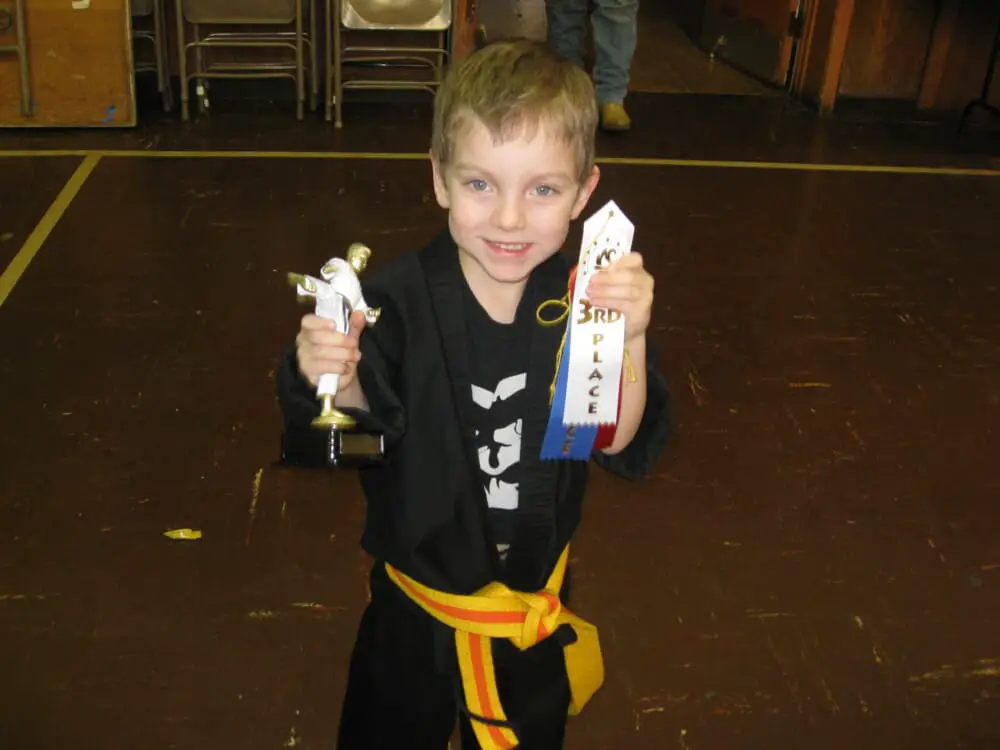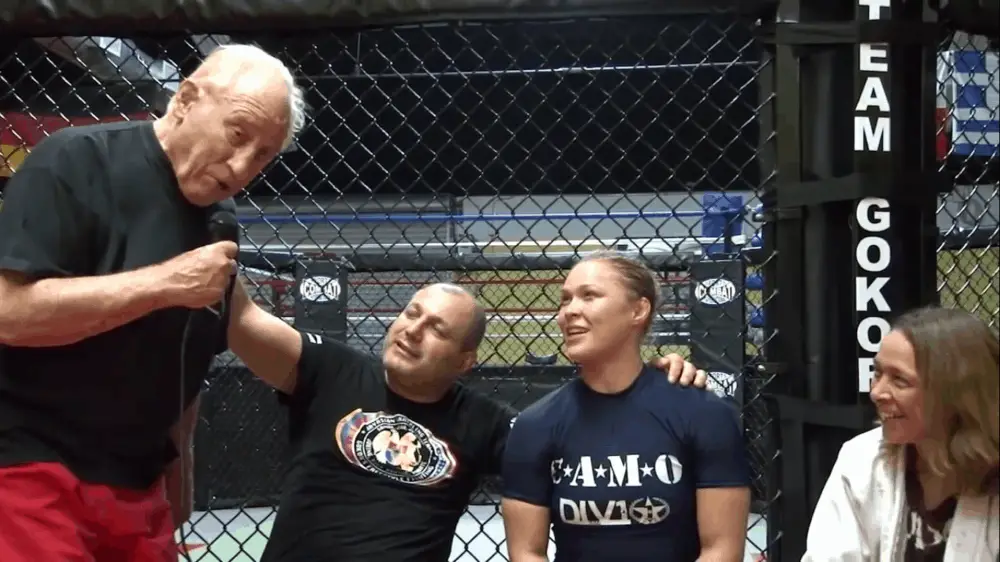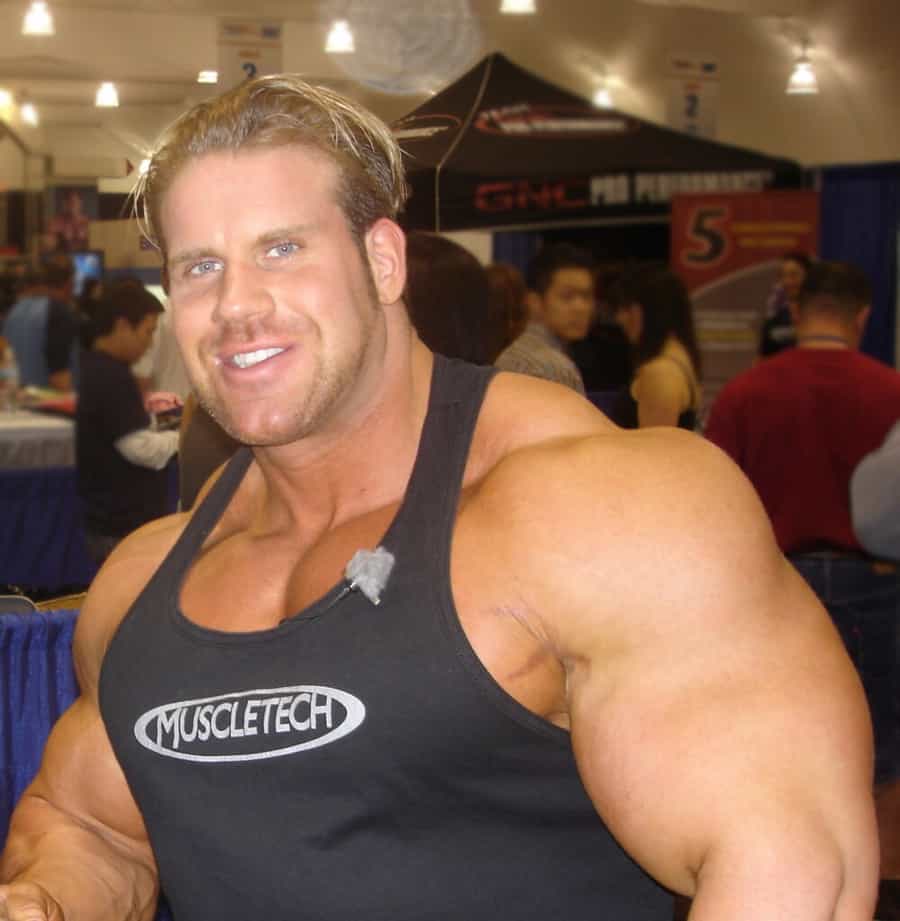
I have been asked on multiple occasions how long it will take to be good at Karate, or at least to become proficient. The answer really depends on many factors such as the instructor, training frequency, the style, and the students fortitude and dedication. Yet, there are some generalities that can be made.
Grasping the core basics of Karate can take about one year with regular training. Students can expect to master the complete set of basics and earn a Black Belt in four to six years. To reach an instructor’s proficiency and advanced degrees of Black Belt, about eight to twelve years are needed.
This also is very dependent on the style studied. For instance, some Karate styles that include the full range of grappling, striking, and weapons training can take as much as ten years to attain a 1st degree Black Belt and master the basics. Though most Karate styles that focus primarily on the Okinawan martial techniques will be in the five year range.
Contents
‘Learning Karate’ Can Mean Many Different Things
What is meant by learning Karate can make the answer change quite a bit. There are several levels of proficiency that can be referred to here, so let’s look at the main ones.
Becoming Comfortable Training in Karate
This level would point to the time it takes to get over the awkward feeling that may accompany a newer student attending classes, competing in tournaments, participating in demonstrations, or even practicing in front of a mirror at home.
All beginning students have some sort of period where they don’t consider themselves martial artists. The techniques may even bring embarrassment due to their newness or a lack of ability to perform them to adequate standards.
This initial period could last for a few weeks. It could also take months for some to become ‘comfortable in their Gis‘. It will depend on physical fitness, self confidence, and having realistic expectations.
Being Proficient in Core Movements
This level of ability can take anywhere from six months to a year and a half. It entails being able to demonstrate basic techniques in a variety of situations with good form and timing.
At this point most students will feel like a burgeoning martial artist, but may not feel as though they have command of techniques in their entirety. There may be confidence in some abilities and lack of trust in their skill with others.
There may have been beginner level experience with sparring, tournaments, and demonstrations. There have been a couple of stressful belt testings or graduations. These all help students get used to operating in the adrenal state.
Getting used to being tired, stressed, or nervous and still having to preform is essential at this stage. Can you perform a technique with the proper timing, form, and power? Now do it exhausted and against multiple opponents. This stage is where boundaries begin to be stretched.
The Black Belt Stage
Now we come to the primary goal of most martial arts students. Though it is usually referred to as a Black Belt, the meaning most invest in this designation is proficiency, self defense ability, and accomplishment.
To reach this level depends on the style, instructor, and ultimately the student. Some styles are so specific and narrowly focused with their techniques that it may only be a few years until those techniques are at this level.
Though, in many styles it will take significantly longer since the amount of material covered, proficiency level demanded, and physicality required is higher. This is not to take away from any martial art system. All have merit if used in the way they were intended and for the purpose they were designed for.
This level is what many see as the terminus of their journey. Yet, once years of study have been undertaken, most students realize why Black Belt is considered the ‘Master of the Basics’. The journey in reality has only begun.
Self Defense, Competition, and Advanced Proficiency
What many don’t recognize is the difference between learning techniques to proficiency and mastering their dynamic use against a resisting opponent. There is a world of difference.
An instructor can’t make a person a winning competitor or a Spiderman level fighter of crime. The level of ability a student attains after techniques are taught and trained is completely up to them.
Self defense is actually a scenerio that a huge amount of time is required to prepare for, but which is the last thing anyone actually wishes to experience. This unpredictable and violent situation takes much more than earning a Black Belt to prepare for.
The same thing can be said of the more controlled environments of tournaments and competitions. The amount of personal training and effort to be successful with them will greatly surpass what it takes to reach a Black Belt level.
Frequency of Training Can Affect The Time It Takes To Learn Karate
So, is your goal to have fun and participate in an activity to increase health and fitness. Then relax and enjoy the journey. It will take considerably longer to learn a style in this manner.
But with this as your goal, it really doesn’t matter how long it takes. The journey in life is sometimes all we are left with in the end. A great internationally successful fighter and amazing martial arts instructor of numerous world champions used to use this as a mantra.

Gokor Chivichyan used to ask us all the time, ‘Are you having fun Buddy?” If our answer was yes, he would always follow up with, “That is the most important thing. You need to have fun.”
Though, what he means by fun and what you may be thinking guaranteed has a different level of stress, sweat, and effort involved. But, I digress. That is a topic for another article.
This really speaks to longevity and ultimately reaching the goal of proficiency in all situations. If you are torturing yourself, you either need to be getting paid well to compensate for it like professional fighters on an international level, or you will simply stop.
You may think you can continue in a miserable training regiment without a high level of compensation, but you are simply mistaken. You will stop.
So, what is a normal frequency for most students? Most schools and instructors require at least once per week and begin to limit attendance at anything over three times per week.
For an professional body guard, international cometitor, or military special forces active duty operative, every day is necessary. Yet, these people are being compensated and it is required for their professions.
For most students, this won’t be the case and without the professional requirement and compensation, they will simply quit. An average of one to two times for classes and two to three 20 minute personal training sessions per week is plenty.
This will keep most on track with the times stated above. If a professional environment is what you seek. You will need a much more extreme and fast paced learning curve.
Be warned. When I was training for international competitions, the multiple bouts in a day seemed like a vacation compared to the torturous training it took to prepare for them. If you don’t have immediacy to train on that level, you will quit and ultimately never reach your goal.
The right amount of training for your goal will equal successfully reaching proficiency. Over-train and you will more than likely never get there.
Style Has a Big Impact on Times To Black Belt
There is a big difference in styles of martial arts. This is even true within a specific category like Karate. There are many different associations, lineages, and instructors with their own schools of thought.
When a style hyper-focuses on a specific aspect of the martial arts, their system tends to exclude many parts of self defense and sport. TaeKwonDo for instance, simply neglects the development of hand techniques, while Judo and Brazilian Jiu Jitsu exclude striking altogether.
Even within this you will find that the focus of a style can play a big role. As in the example of Judo vs Brazilian Jiu Jitsu the times for Black Belt and proficiency is wildly different.
Judo has a set amount of throwing techniques and only a portion of those are used in competition. This makes mastering what it offers pretty straight forward and in the three to five year time frame.
Yet, with BJJ there is a whole different story. The techniques are ever developing and ever more intricate and complex. With the emphasis on practical ground sparring proficiency, the times to mastery and Black Belt could literally take decades.
In Karate there are many different forms and styles with their own associations and histories. Most come from the Chinese influence as it found its way to Japan through Okinawa. Yet, from there it has thousands of branches.
For a detailed list of the top 20 styles, belt ranks, and times to Black Belt, see my article here.
What is important for the question at hand is, how can these styles make reaching your goal easier or harder. There is a core value at the heart of most of these styles. Once grasped, the road to mastering the majority of that style becomes much more clearly defined.
Some styles lift up competition in tournaments and sparring proficiency as the main goal. Others are more concerned with preparing for many types of self defense scenarios. Still others are rooted in the tradition, culture, and history of their country of origin and the lineage of their style.
Though all will have elements of each, once you grasp the central important goal of your style, your progress toward that shared goal tends to move along at a faster pace. Just make sure that your reasons for beginning training in the first place line up with the goals of the instructor and style.
Instructors Are a Large Factor In Learning Karate
If you visited the link above that takes you to my article about the top 20 Karate styles, you will come across some styles that are heavily dependent on instructor preference when it comes to testing and moving on to other more advanced techniques.
There are Karate styles and others like the above mentioned Brazilian Jiu Jitsu that do things a lot like this. Instructors are relied upon to give rank, certify that the student is ready or proficient enough, and ultimately the rank earned is attached to the instructor that gave it.
There are several variations of this in some Karate systems as well. The more internationally or even nationally governed the style the less you will see this on the local instructor level. Much has been decided by higher ranking instructors in leadership positions.
Even some of these can leave much up the the local instructor. But, generally speaking, the smaller organizations where the knowledge comes from a few lines directly linked to the system’s founder, are much more likely to have nearly full discretion on techniques learned and rank earned placed in the hands of the local teacher.
In instances like this, the time it takes to learn the Karate style depends on the pacing the instructor feels is best overall or simply for the individual student. This is one reason a quality instructor is essential. This is true for all styles, but for those relying heavily on the local instructor to set goals and standards, it is paramount.
There is also the goal of the instructor to take into account when awarding rank and access to more advanced learning opportunities. I have had a lot of experience dealing with instructor personalities and frankly, insecurities.
For one example, I and several of my then students would together take classes in a completely different style from our own. At the time, this was not normal. So the instructor was very leery teaching us anything beyond the very basics of his system. It became a problem.
If you feel that you are on a time frame where learning a specific martial art is concerned, pay attention to how the instructor paces the learning. Sometimes taking a while with certain sections of material is warranted or even strongly advised. Though this may not always be the case.
Here I am not really referring to rank, since that is actually hyper-subjective. I am speaking about pacing on learning material and adding practical drills to make the techniques more ‘real world’ applicable.
Fitness Level Can Help or Hinder Progress
This may sound surface and self-explanatory on first glace. Like many things, it is a bit more complex once you look into it. There are considerations like obesity, atrophy, asthma, and even too much muscle mass.
Let’s break it down slightly. There are two main categories you might say. One would be a lack of physical fitness and the other could be stated as too much.
Lacking Physical Fitness Can Hinder Karate Progress
Obesity can make the journey to learning Karate noticeably longer. The reason is that for a sizable portion of the techniques in Karate, fast reflexes and good cardio conditioning may be required. This is especially true as one progresses into higher level material.
I am not specifically speaking to jumping, rolling, or running. That may be true. In general it carrying too much excess weight makes learning an performing the techniques much more difficult. It is like trying to run in a swamp. Can it be done? Maybe. Should it be done? That is a better question.
First, a student may have to shed some of the excess weight. That can be done while learning in the beginning stages. There is no doubt. It will however make the process a bit more challenging. As well, losing excess weight is usually not measured in weeks. It usually takes months to years to accomplish.
There is also the case of total inactivity or underweight scenarios. This would be someone who has never attempted to get into shape or put on muscle size or strength. The journey may be slowed in the same way as someone with too much weight.
Too Much Muscle Mass Could Get in the Way

One issue that many might not recognize as a problem would be when someone has put on an extreme amount of muscle weight. This could be the case with body builders or power lifters.
This extreme state that they have put their bodies into has made them good at lifting heavy objects in predefined ways. There can be no doubt about that.
The problem comes when they are required to be flexible or display good cardiovascular levels. Here we will find that they have a lot of trouble. As you can imagine, there is not much in the martial arts that doesn’t require these two.
Many of these oversize individuals, due to their style of training have a big problem with flexibility. Normally they have also suffered numerous injuries that are linked to heavy lifting. These tend to slow the progress in martial arts proficiency.
One aspect that many may not know about carrying that much muscle mass, is the difficulty that nearly all of them have with cardio vascular exercise. They may attempt to maintain a decent cardio level, but it is a huge struggle.
The reason is simple. The larger the muscle mass, the more heat it generates. The more heat it generates the more oxygen it consumes. This causes lungs to work overtime doing tasks that may not otherwise be very exerting.
This is not to say at all that those with large muscle masses can’t train in the martial arts. Not at all. This is just to say it can slow down progress like wearing weighted vests can slow down your mile running time. It can affect the time it takes to reach your goal.
The Learning Karate Takeaway…
“The main thing buddy… Are you having fun?”
Gokor Chivichyan
U.S. and World Champion
Trainer of MMA, Judo, Sambo, and Submission Grappling U.S. and World Champions
Though you definitely have goals and don’t intend on being a novice forever, set back and enjoy the journey. You will find you may enjoy parts of it you never thought you would.
Just trying to skip to the end not only causes us to miss the best parts, it also means many times we give up on the whole project. There is a good saying that some Karate instructors use and even have on their walls.
“A Black Belt is just a White Belt who didn’t quit.”
Most Any Karate Instructor
